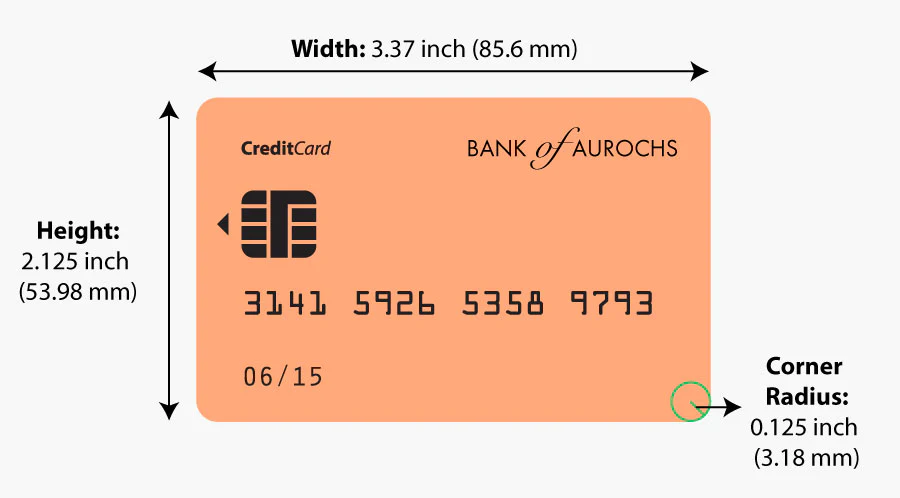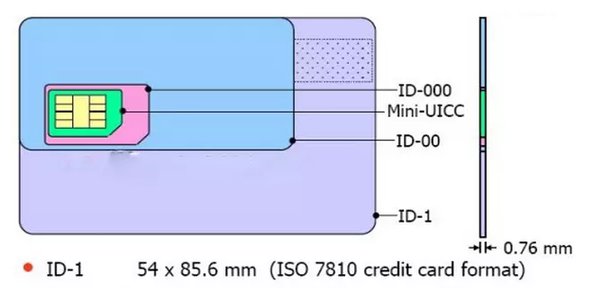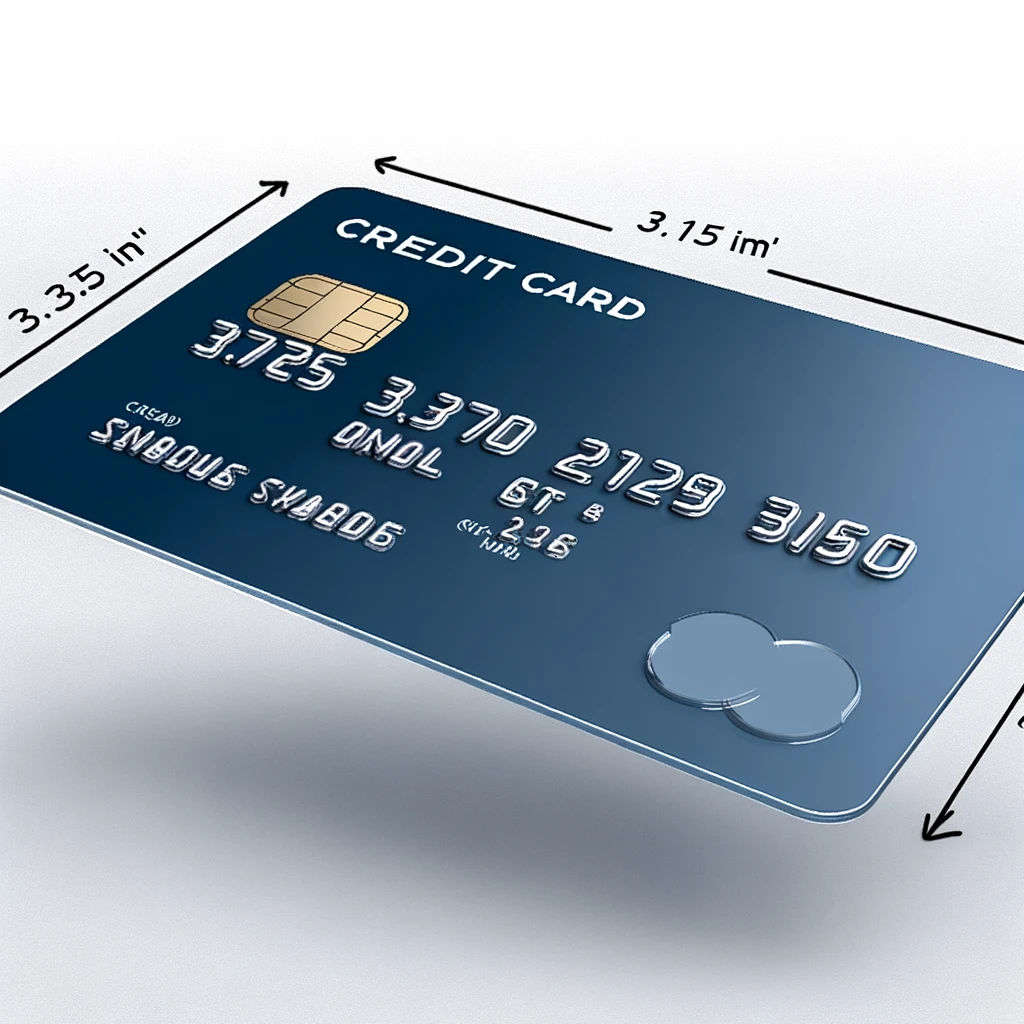In today’s cashless society, credit cards have become an essential tool for financial transactions, offering convenience and security to consumers worldwide. However, amidst their widespread use, have you ever paused to ponder the dimensions of these ubiquitous plastic cards? Surprisingly, these seemingly trivial details hold significant importance, influencing everything from card design to compatibility with card readers and ATMs.
Standard Credit Card Dimensions in Inches
Credit cards adhere to standardized dimensions to ensure consistency across financial institutions and payment systems. The typical dimensions of a credit card in inches are:
| Dimension | Measurement |
|---|---|
| Length | 3.375 inches |
| Width | 2.125 inches |
These dimensions, often referred to as the ISO/IEC 7810 ID-1 format, enable credit cards to fit seamlessly into wallets, cardholders, and card slots. Additionally, the corners of credit cards are usually rounded to a radius of 0.125 inches to prevent damage and enhance durability.

Thickness of a Credit Card
Beyond length and width, the thickness of a credit card is equally vital. Standard credit cards typically have a thickness of approximately 0.03 inches or 0.76 millimeters. This optimal thickness strikes a balance between flexibility and rigidity, ensuring the card remains sturdy during regular use.
Why Thickness Matters
- Compatibility: Ensures the card fits properly in wallets and cardholders.
- Durability: Prevents bending or breaking during handling and transactions.
- Perception: Contributes to the card’s perceived quality and reliability.
Understanding Credit Card Dimensions
Credit cards, regardless of type, maintain a standardized size to ensure compatibility with various machines and terminals. Here’s a breakdown of credit card dimensions:
| Measurement | Value |
|---|---|
| Width (cm) | 8.56 |
| Height (cm) | 5.398 |
| Width (mm) | 85.6 |
| Height (mm) | 53.98 |
| Width (inches) | 3.375 |
| Height (inches) | 2.125 |
These dimensions remain constant across all credit cards, facilitating ease of use and universal acceptance.

Other Dimensions of a Credit Card
In addition to length, width, and thickness, credit cards feature several other dimensions that contribute to their design and functionality:
| Feature | Measurement |
|---|---|
| Embossed Numbers | Height: 0.02 inches |
| Magnetic Stripe | Width: 0.75 inches |
| Signature Panel | Length: 2.75 inches, Height: 0.625 inches |
| Chip | Approximately 0.3 inches square |
Variations in Credit Card Dimensions
While most credit cards adhere to standard dimensions, there are exceptions based on card type and issuer preferences:
- Contactless Cards: Equipped with NFC technology, these cards may be slightly thicker (around 0.04 inches).
- Premium Cards: Often feature unique designs and dimensions to denote exclusivity.
- Co-Branded Cards: Variations may occur based on partnerships with specific organizations.
Importance of Standard Credit Card Dimensions
The adherence to standard credit card dimensions offers numerous benefits:
- Compatibility: Ensures seamless integration with payment systems worldwide.
- Usability: Optimal dimensions for easy handling and storage.
- Efficient Processing: Facilitates quick and accurate transactions.
- Interchangeability: Allows cards to be used across different financial institutions.
- Global Acceptance: Promotes widespread acceptance and ease of use.
Also read: eLoanWarehouse
Material Composition of Credit Cards
Most credit cards available today are crafted from plastic, particularly PVC (polyvinyl chloride). PVC is prized for its density, water resistance, flexibility, and durability, making it an ideal choice for credit cards subjected to frequent usage.
However, recent years have witnessed a surge in the popularity of metal credit cards. These sleek alternatives offer enhanced durability and aesthetics compared to traditional plastic cards.
The Significance of Standardized Sizes
The uniformity in credit card sizes isn’t merely for aesthetic or practical reasons; it’s rooted in international standards established by the International Organization for Standardization (ISO). These standards, applicable across ISO member nations, ensure interoperability and ease of use across diverse payment systems worldwide.
Why Standardization Matters
Standardization simplifies payment processes by enabling consistent compatibility with various payment terminals and machines. Whether you’re swiping your card at a retail store or withdrawing cash from an ATM, adherence to standardized sizes ensures seamless transactions.
Weight and Thickness Variations
While credit cards adhere to specific dimensions, they may vary in terms of weight and thickness. Metal credit cards, for instance, boast a significantly higher weight compared to their plastic counterparts.
| Material | Weight (grams) | Thickness (mm) |
|---|---|---|
| Plastic | ~5 | 0.76 |
| Metal | ~17.5 | 0.76 |
Despite these variations, both plastic and metal credit cards adhere to the ISO-mandated thickness of 0.76 mm.
Conclusion
In conclusion, while the dimensions of credit cards may appear inconsequential, they play a vital role in shaping the financial landscape. Standardized dimensions ensure compatibility, convenience, and efficiency in transactions, underscoring the importance of these seemingly small details in our cashless society. So, the next time you reach for your credit card, take a moment to appreciate the precision and thought behind its design and dimensions.



